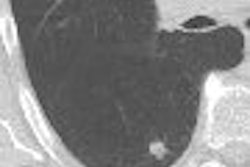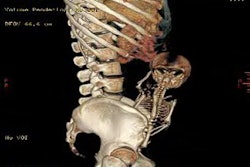Following up extracolonic findings in virtual colonoscopy can be a terrific deal for the patient whose life is spared. But in an older, symptomatic population of VC patients, following up on all potentially significant findings is expensive, according to a new study in the British Journal of Radiology.
In a cohort of 225 patients with symptoms suggestive of colorectal cancer, the cost of follow-up care more than doubled the cost of virtual colonoscopy and consumed significant resources, researchers from the U.K. reported.
The cost of care amounted to more than five times that of previous studies conducted in the U.S., possibly because it included the cost of interventions related to the findings rather than only diagnostic exams, the authors suggested. Then again, because the researchers found several large abdominal aortic aneurysms and early malignancies, the expenditures may have been cost-effective based on the U.K. standard of 30,000 pounds ($54,747) per healthy life year saved.
"The prevalence of extracolonic findings found at CT colonography (virtual colonoscopy or VC) is high; when (VC) is used as a diagnostic method in symptomatic patients, 52% of patients have one or more incidental lesions," wrote Ph.D. student Tengbin Xiong; Richard Lilford, Ph.D., from the University of Birmingham in the U.K.; Dr. Dion Morton and Katherina McEvoy from Queens Hospital Birmingham; and Dr. Steve Halligan from the University College London. "While detection of curable lesions such as early renal cell carcinoma would benefit some patients, other lesions such as resorbing uterine fibroids are of no importance" (British Journal of Radiology, July 5, 2006).
The results of an earlier study by the group (British Journal of Surgery, in press), in which 116 of 211 symptomatic patients had extracolonic findings, were used in the present study to assess the clinical resources and costs associated with the investigation and treatment of those extracolonic lesions, the authors wrote.
All 116 of the patients with an abnormality detected at VC were followed up for 12-24 months, the authors wrote, and 24 patients underwent further actions including outpatient attendance, investigations, or surgical procedures "as a result of previously undiagnosed lesions unrelated to colon cancer," they wrote. "The costs of these further actions were derived from the NHS reference costs manual," while indirect costs and costs of care, lost productivity, etc. were not included.
Excluded from analysis were conditions that been diagnosed previously, as well as extracolonic metastases from primary colorectal tumors in eight patients. Among the 24 patients who underwent intervention, 75% were older than age 70, 63% were women, and 78.8% of the costs were generated by female patients, owing to a large proportion of findings related to the female reproductive organs.
The total cost of all actions resulting from detecting incidental lesions among the 24 included patients was 34,329 pounds ($62,655), or averaged over all 225 patients in the cohort, $279 per patient.
"Eleven percent of patients (24/225) underwent at least one further action and the 95% confidence limit on this proportion ranges from 7% to 15%," the researchers wrote. "Extrapolating the cost estimates across this range provides a cost interval of 97 pounds to 208 pounds ($177 to $379). The cost of general practitioner consultations was also excluded from analysis."
Most of the money was spent on a small number of patients, including six whose costs exceeded 2,000 pounds, the researchers reported. "The total cost for these six patients (27,665 pounds) accounted for 80.6% of the total cost spread over all 225 patients," they wrote. "Inpatient bed stays, especially among those undergoing elective surgery, accounted for 75% of all costs. Radiological examinations constituted the most common category of clinical event, but the cost of these investigations amounted to only 3.3% of total costs (1,125 pounds or $2,053)."
"The most clinically significant extracolonic lesions detected were abdominal aortic aneurysms (over 5 cm) and early-stage cancers," the group explained. "The detection rates of (VC) for N0M0 cancers and significant aneurysms are 2.5% and 1.7%, respectively, among symptomatic patients in our systematic review."
Combining the study with the review yielded percentages of 2.0% (95% CI 1.0%, 2.9%) and 1.9% (95% CI 1.2%, 2.5%), respectively. "Therefore, on average we may expect about four (two to six) patients with early stage cancers and four (two to five) with early stage aneurysms to be detected among every 200 people undergoing (VC)," the group wrote.
Other extracolonic findings included liver and kidney lesions and cysts, a liver hemangioma, a pelvic mass, ovarian cysts and masses, uterine fibroids, and a urinary system obstruction.
At the U.K. cost threshold of 30,000 pounds ($54,747) for a healthy life year saved, the discovery of incidental lesions would be cost-effective if detecting preclinical lesions resulted in at least one life year saved per 200 patients.
"The most common primary cancers detected incidentally by (VC) are those of the kidney and ovary, where there is a favorable survival advantage for treatment of earlier lesions," the authors wrote.
The study was conducted in a symptomatic population that is older than a screening population, and therefore has potentially fewer life years to gain as a result of successful intervention. On the other hand, an older symptomatic population offers the potential of finding a greater number of serious diseases, they noted.
"Our results show that the mean costs arising from the detection of incidental lesions are likely to be greater than those of the primary (VC) itself," the researchers concluded. "Those who judge that finding four early cancers and a similar number of large aneurysms among 200 patients is more likely than not to save at least one year of life on average may regard the cost of investigating and treating incidental lesions as one worth paying."
By Eric Barnes
AuntMinnie.com staff writer
July 20, 2006
Related Reading
Tagged VC succeeds where colonoscopy fails in elderly, March 28, 2006
VC would raise screening costs, study concludes, October 31, 2005
Serious extracolonic findings prevalent in screening, symptomatic VC patients, August 17, 2005
VC shows extracolonic findings in most patients, July 28, 2005
VC with contrast finds more extracolonic trouble, April 11, 2005
Panoply of VC studies yields significant extracolonic findings, March 23, 2005
Copyright © 2006 AuntMinnie.com



















